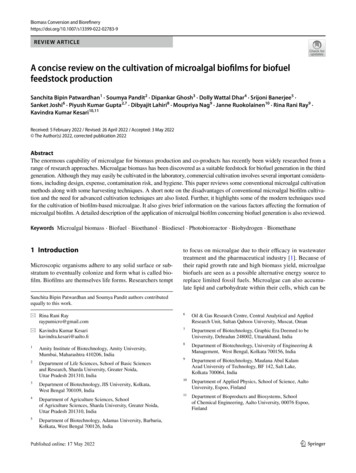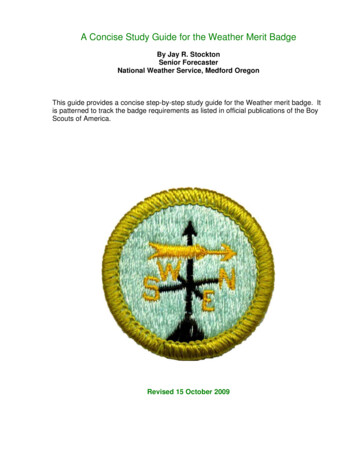
Transcription
Biomass Conversion and 3-9REVIEW ARTICLEA concise review on the cultivation of microalgal biofilms for biofuelfeedstock productionSanchita Bipin Patwardhan1 · Soumya Pandit2 · Dipankar Ghosh3 · Dolly Wattal Dhar4 · Srijoni Banerjee5 ·Sanket Joshi6 · Piyush Kumar Gupta2,7 · Dibyajit Lahiri8 · Moupriya Nag9 · Janne Ruokolainen10 · Rina Rani Ray9 ·Kavindra Kumar Kesari10,11Received: 5 February 2022 / Revised: 26 April 2022 / Accepted: 3 May 2022 The Author(s) 2022, corrected publication 2022AbstractThe enormous capability of microalgae for biomass production and co-products has recently been widely researched from arange of research approaches. Microalgae biomass has been discovered as a suitable feedstock for biofuel generation in the thirdgeneration. Although they may easily be cultivated in the laboratory, commercial cultivation involves several important considerations, including design, expense, contamination risk, and hygiene. This paper reviews some conventional microalgal cultivationmethods along with some harvesting techniques. A short note on the disadvantages of conventional microalgal biofilm cultivation and the need for advanced cultivation techniques are also listed. Further, it highlights some of the modern techniques usedfor the cultivation of biofilm-based microalgae. It also gives brief information on the various factors affecting the formation ofmicroalgal biofilm. A detailed description of the application of microalgal biofilm concerning biofuel generation is also reviewed.Keywords Microalgal biomass · Biofuel · Bioethanol · Biodiesel · Photobioreactor · Biohydrogen · Biomethane1 IntroductionMicroscopic organisms adhere to any solid surface or substratum to eventually colonize and form what is called biofilm. Biofilms are themselves life forms. Researchers temptto focus on microalgae due to their efficacy in wastewatertreatment and the pharmaceutical industry [1]. Because oftheir rapid growth rate and high biomass yield, microalgaebiofuels are seen as a possible alternative energy source toreplace limited fossil fuels. Microalgae can also accumulate lipid and carbohydrate within their cells, which can beSanchita Bipin Patwardhan and Soumya Pandit authors contributedequally to this work.* Rina Rani Rayraypumicro@gmail.com6Oil & Gas Research Centre, Central Analytical and AppliedResearch Unit, Sultan Qaboos University, Muscat, Oman* Kavindra Kumar Kesarikavindra.kesari@aalto.fi7Department of Biotechnology, Graphic Era Deemed to beUniversity, Dehradun 248002, Uttarakhand, India8Department of Biotechnology, University of Engineering &Management, West Bengal, Kolkata 700156, India9Department of Biotechnology, Maulana Abul KalamAzad University of Technology, BF 142, Salt Lake,Kolkata 700064, India10Department of Applied Physics, School of Science, AaltoUniversity, Espoo, Finland11Department of Bioproducts and Biosystems, Schoolof Chemical Engineering, Aalto University, 00076 Espoo,Finland1Amity Institute of Biotechnology, Amity University,Mumbai, Maharashtra 410206, India2Department of Life Sciences, School of Basic Sciencesand Research, Sharda University, Greater Noida,Uttar Pradesh 201310, India3Department of Biotechnology, JIS University, Kolkata,West Bengal 700109, India4Department of Agriculture Sciences, Schoolof Agriculture Sciences, Sharda University, Greater Noida,Uttar Pradesh 201310, India5Department of Biotechnology, Adamas University, Barbaria,Kolkata, West Bengal 700126, India13Vol.:(0123456789)
Biomass Conversion and Biorefineryturned into biodiesel and bioethanol, respectively [2]. Microalgae cultivation is necessary for biofilm production.Conventional techniques involve dispersing the microalgae in a liquid medium [3]. These methods, however, suffer from various limitations, such as lower biomass yield,cumbersome harvesting of biomass and retrieval, increasedcost of installation and functioning, and a greater necessityfor water. The other major drawback of using conventionalcultivation method involves difficulty in maintaining sterilityand high chances of contamination of cultivated algae [4].Moreover, these methods cannot be used for production ofmicroalgae on large scale as it is difficult to grow specificalgal cultures for extended periods with consistent quality. Hence, microalgal biofilms prove a pioneering strategywhere microalgae are cultivated to produce biofilms[4]. Thismethodology, thus, overcomes the limitations of conventional frameworks of cultivation [5].Biofilm-based cultivation of microalgae has garneredconsiderable attention as a viable platform for algal development as well as other uses like treating wastewater [6].Conventional suspension systems have not yet to prove itseconomic viability, so algal biofilm cultivation technologiesoffer an alternative. One of the most significant benefits ofalgal biofilm systems is that algae may be harvested simply by scraping, avoiding the costly harvesting techniquesemployed in conventional suspension-based harvestingincluding centrifugation and flocculation [7]. Microalgaebiofilm is an immobilized cultivation method that yieldsenergy, as well as several environmental advantages, including bioenergy generation, nutrient retrieval, and carbonsequestration [8], while simultaneously improving the finalyield of biomass and algal cell density [9, 10]. Microalgaealso offer tolerance to growth stresses, higher cell density,and economic feasibility concerning harvesting and concentration [11, 12]. Another advantage of microalgae biofilm istheir multi-layer construction involving horizontal, vertical,and rotating configuration, enhancing the yield per groundarea and the efficacy of ground use [7, 13, 14]. Biofilm reactors are developed to treat wastewater by utilizing microalgae [15]. Mixotrophic cultivation is preferred because algaenurture in autotrophic and heterotrophic conditions whenan appropriate amount of sunlight, inorganic and organiccarbon compounds are supplied [16]. The main objectiveof this study is to analyze a new and innovative cultivationapproach called a mixotrophic microalgae biofilm, for theeconomic cultivation of algal feedstock [17, 18].Microalgal biofilms are investigated from both technological and ecological characteristics. Implementation of thesebiofilms in aquaculture, wastewater treatment, and upgradingof antifouling chemicals are a major scientific aspect in thecurrent society [19, 20]. As every technology intends to havesome negative impact, microalgal biofilm too suffers fromfouling. However, knowledge in this aspect is still a mystery.13Extended probes need to be more rivet on fouling including mitigation strategies in near future. The following studyintends to revise the current literature regarding microalgalbiofilms as a novel technique. Current investigative researchaims to summarize the current state of known research dataon the significant features and synergistic properties of biofilm formation in either marine or freshwater environments.This extensive literature review primarily concentrates onthe various conventional cultivation strategies of microalgalbiofilms along with their advantages and disadvantages. Further, it highlights recent techniques used for the productionof microalgal biofilms and their advantages over traditionaltechniques. It also describes different factors obstructing theirapplications, mixotrophic cultivation of microalgae with adetailed description of the requirements, protocol, and statistical analysis. Algal biomass yield, impacts of cell-surface characteristics upon the exploitation of microalgae biofilm, algalfeedstock quality, and growth metabolism of microalgae biofilmin wastewater are a few other topics covered. The significanceand implementation of microalgal biofilms with the scope oftheir efficiency in the future are reviewed in this paper.2 Basics of microalgaeMicroalgae are generally unicellular microorganisms withthe potential to aggregate, which allows them to developvarious cell structures including unicellular, colonial, andfilamentous. Microalgae have recently attracted scientificinterest after being identified as a raw material for the processing and manufacturing industries. These bacteria appearto have a variety of advantages. Fourth-generation biofuels,fertilizers, aquaculture feed, nutraceuticals, and wastewatermanagement are some of their applications.Due to the advantages listed below, microalgae production is preferred over other terrestrial plant cultivation.a) Their chemical structure varies depending on the mediain which they are grown. This is because they have largebiomass biodiversity [21].b) They do not compete for agricultural land with terrestrialplants because they do not require land for their cultivation [6].c) Wastewater can be used to meet their nutritional andwater requirements [22].d) There are no seasonal restrictions on their cultivation,and certain species may persist in harsh environments.They double their biomass in a couple of hours, resultingin a significant increase in production [23].e) They vitiate the environmental eco-dynamics lessbecause they use fewer pesticides and fertilizers [24].f) They could also provide the added benefit of phycoremediation by removing contaminants (like nitrogen, phos-
Biomass Conversion and Biorefineryphate, and heavy metals) from liquid waste streams and CO2 from the atmosphere [25].g) Some microalgal species produce more bioenergy persquare metre than traditional oil crops [26]. Microalgalspecies are regarded a viable feedstock for bioenergygeneration due to their comparatively high lipid content.Because the lipids obtained from microalgae are chemically comparable to traditional vegetable oils, they havebeen demonstrated as a potential bioenergy source. Forinstance, in one of the studies, algal culture technologiessuch as raceway ponds, vertical tank reactors (VTR),and polybags were investigated for large productionof algal consortia using carpet industry (CI) untreatedwastewater,. Polybags (21.1 g m 2 day 1) had the highest overall areal biomass yield, followed by VTR (8.1 g m2 day 1) and raceways (5.9 g m 2 day 1). Using 20 and30 L capacity polybags with triple row arrangement, abiomass productivity of 51 and 77 t h a 1 year 1 may beattained, respectively. Proteins accounted for 53.8% ofthe biomass recovered from the algal consortium, whilecarbohydrates (15.7%) and lipids (5.3 %) were low. Apolybag-grown consortium showed the capacity to produce 12,128 m3 of biomethane per year [27]. Table 1shows various algal species used for the production ofbioenergy.In the last few decades, there has been a lot of studytowards making biofuel from microalgae biomass. Microalgae, being autotrophic organisms, synthesize organic macromolecules such as lipids and carbohydrates that can beprocessed into biofuel using solar energy and atmospheric CO2. As a result, algae have the potential to supply a carbonneutral fuel with hardly any inputs. Some microalgal speciescan be grown heterotrophically for increased productivity,however this necessitates the addition of carbon feed. Microalgae are of particular interest because some strains producesignificant amounts of oil, primarily the glycerolipid triacylglycerol (TAG), which can be transesterified into biodiesel[33]. Microalgae’s high oil generation means that much lessland would be required to generate the same amount of biofuel as oil crops like soybean or oilseed [34]. Microalgae areTable 1 Microalgae commonlyused for the productionbioenergyalso intriguing as some strains have the potential to createhydrogen, which might be employed as a fuel source. Furthermore, some microalgae, particularly Botryococcus braunii, can produce significant concentrations of unique triterpenic hydrocarbons that can be easily turned into fuels usingtraditional hydrocracking and distillation methods [35]. Inconclusion, microalgae can produce 58,700 l of oil per hectare and 121,104 l of biodiesel per hectare, making them apromising alternative to conventional fossil fuels [36].3 Cultivation of microalgaeMicroalgae biomass has been discovered as a suitable feedstock for biofuel generation in the third generation. Althoughthey may easily be produced in the lab, commercial cultivation necessitated several important considerations, includingdesign, cost, contamination risk, and cleanliness. Microalgaenaturally develop in lakes, rivers, and oceans, but such ecosystems are unsuitable for large-scale extraction due to lowbiomass densities. Recently, 23.8 million wet tons of algaewere farmed to meet commercial demand [37]. Organic andinorganic chemicals have been widely used as viable nutrient media for extensive microalgae cultivation. However, itsuse is hindered by its high cost and environmental hazards,which may make large production of microalgae biomassimpractical. As a result, organic fertilizers and wastewaterfrom the home and industrial runoffs have been offered aslow-cost nutrient mediums for successful production.Microalgal cultivation is categorized into five differentmetabolic pathways. Photoautotrophic cultivation is mainlybased on the growth of photoautotrophs for the synthesis ofbiofuel. Photoautotrophs are organisms that generate organiccompounds using light energy and inorganic carbon. Photosynthesis is carried out by all identified photoautotrophs.Plants, algae, and cyanobacteria are the best examples. Amicrodroplet photobioreactor is used for the culture of photoautotrophic algal cells [38]. Heterotrophic microalgae canthrive in the dark by consuming organic substances as thesources of carbon and energy [39]. Heterotrophic culturepromotes lipid accumulation and would be advantageous inproducing biodiesel. Mixotrophic cultivation is intriguingSr. no. Algal speciesCultivation technique used ProductReference1.2.3.Ostreococcus tauriDunaliella salinaChlamydomonas reinhardtiiPhotobioreactorBrackish seawater pondsPhotobioreactor[28][29][30]4.5.Botryococcus brauniiPhotobioreactorSynechocystis and Synecococcus PhotobioreactorOilsβ-CaroteneOils, carbohydrates,hydrogen, andmethaneTriterpene oilsIsoprenes, oils[31][32]13
Biomass Conversion and Biorefinerybecause algae can develop by utilizing sunlight and inorganic or organic carbon under autotrophic and heterotrophicconditions simultaneously. Mixotrophic growth can enhanceresource utilization and reduce issues related to light constraints, resulting in a faster growth rate and increased lipidconcentration [16]. Photoheterotrophs are heterotrophic phototrophs that rely on light for energy but cannot live solelyon carbon dioxide. As a result, they rely on environmentalorganic substances to meet their carbon needs [40].Various cultivation techniques including traditional andmodern methods are described in the paper below.3.1 Conventional cultivation techniquesOpen ponds and closed photobioreactors are the two basictypes of microalgae cultivation methods [41].An enclosed PBR can be best defined as a man-madeclosed vessel that helps microalgae cells to carry out photosynthesis upon exposure to light as an energy source.However, economic risks are evident as the constructionand operating cost of a PBR is higher than the pond system. Microalgae cultivation in enclosed PBR, on contrary,requires less or no agricultural land. Microalgae can begrown in enclosed PBRs on nonarable soil with nutrientssupplied by wastewater treatment [42]. The most wellknown closed culture systems utilized on a commercial scalefor microalgae cultivation are tubular and flat-panel PBRs.Tubular PBR is typically made up of horizontal, vertical,fence-like, inclined, or helix-shaped glass or plastic tubesarranged in horizontal, vertical, fence-like, inclined, or helixarrangements. The tubular solar array has been designed andconfigured to capture as much sunlight as possible. Theyare organized in a row, parallel to each other, and flat onthe surface. These horizontal solar tubes can also be placedFig. 1 Different PBRs. a Airliftreactor with orifice sparger. bHelical reactor. c Flat panelrocking reactor. d Bioengineering controlled reactor. e Bubblecolumn reactor with orificesparger. f Flat panel reactor. gBubble column reactor withring sparger. h Internal LEDlight illuminated controlledreactor. i Twenty-liter airliftreactor with orifice sparger.Courtesy: - Biohydrogen Lab,Indian Institute of TechnologyKharagpur, West Bengal, India13in a fence-like pattern to incorporate more tubes in a givenarea [43].Closed algal cultures (photobioreactors) are coated witha transparent substance or housed within clear tubes and arenot exposed to the atmosphere. Photobioreactors have thedistinct benefit of not permitting water to evaporate (Fig. 1).Microalgae growing in these types of systems have theadded benefit of decreasing contamination hazards, limiting CO2 emissions, providing repeatable cultivation conditions,and versatility in system designs. Photobioreactors, bothclosed and semi-closed, are primarily utilized to producehigh-value algal products [41].The separation of biomass from treated wastewater hasbeen one of the primary challenges in the use of microalgaefor wastewater treatment. As a result, a fixed system, suchas the biofilm PBR, has been suggested as a more adaptablealternative to the standard suspension method. Microalgaecells adhere to supporting elements in the biofilm PBR, andwastewater is delivered via the biofilm, which decreasesthe nutrient content that reaches the microalgae. The mostimportant component that influences the efficacy of biofilmPBR is the selection of supportive materials for microalgae adhesion. The supporting material can be divided intotwo categories: biomaterial and non-biomaterial, with therougher the surface of the materials, the easier it is formicroalgae to adhere. While choosing the supporting materials, other factors such as microalgae strain and wastewaterproperties must be taken into account. To prevent reactionsbetween materials and compounds in particular types ofwastewaters, control measures must be taken [44].The principal disadvantage of closed photobioreactors isthat they are less cost-effective than open ponds. Closed systems now have several disadvantages, including high infrastructure costs, energy (pumping and cooling) operation, and
Biomass Conversion and Biorefinerymaintenance [such as cleaning and sterilization, as well asscaling up challenges [45]. However, if these challenges canbe addressed, these closed systems with controlled situations may be facilitated for commercial mass production ofa greater number of microalgal species in a wider range oflocations [46] (Table 2).Microalgae biomass is the right approach for commercial biofuel production as a dynamic approach, andthe variety of ways to culture microalgae is of primaryinterest. Microalgae cultivation in open ponds using solarenergy has been well-known for more than 60 years andcan be performed in open or covered spaces, in naturalwaterways (lakes and lagoons), or man-made shallowbasins [42]. A few open pond systems, such as natural,circular, raceway, and inclined systems, are accessibleand are preferred for most commercial activities, owingto their convenience and cost-effective construction features, as well as higher production capacity than closedsystems [51]. In terms of nutrient availability, runoff waterfrom land areas is prevalent, but the strategy of integratingmicroalgae cultivation with sewage or wastewater treatment plants is now attracting interest from a variety ofindustries as a phytoremediation tool and a way to reduceupstream processing costs. Overall, the open pond system excels in terms of financial prospects and simplicity of scalability, even though the huge scale synthesis ofmicroalgae is hampered by physical, chemical, and biological variables that must be addressed comprehensivelybefore the technology can be implemented. Apart fromthe requirement of a large amount of space to set up anopen pond system, microalgae resistance to such cultivating methods is triggered by changes in the surroundingand cultural circumstances, as well as unsupervised solarlight intensity and temperature. Because sunlight can onlyreach a specific depth in pond water and thus microalgaeexposure to sunlight is inconsistent, poor light intensityand dispersion has an impact on microalgae growth andcell density. The inability to maintain an optically darkzone is another shortcoming of an open pond system [52].Because evaporation is used to cool the system, a lackof control over the culture temperature leads to excessivewater evaporation and, as a result, C O2 diffusion into theatmosphere. Another issue with open pond cultivation isthe high sensitivity to contamination by foreign predatorsand the flourishing of heterotrophs that feed on the algae,making such a system only practicable for microalgae thatcan survive harsh environmental conditions. Although alarge and growing body of literature papers on the longterm success of open pond cultivation systems, anotherdisadvantage is the inadequate mixing mechanisms provided by the paddlewheel (in open raceway ponds) andpivoted agitator (in open circular ponds), which result inreduced mass transfer and ultimately reduced volumetricproductivities [51].The other conventional techniques used for the cultivation of microalgal species are algal turf scrubber (ATS) andhybrid cultivation systems (HCS). Water flows across asloped surface in ATS, which encourages the developmentTable 2 Advantages and disadvantages of conventional cultivation systemSr. no. Type of cultivation system1.AdvantagesClosed photobioreactor systems Environmental factors are under controlincluding pH, temperature, and intensityof light.Ideal for a specific species of microalgae.Enough light is accessible.2.Open pond3.Algal turf scrubber (ATS)4.Hybrid cultivation systemContamination is reduced to a minimum.Simple structure.Convenient to use.Low investment and operating expenses.Solar lighting is freely available.Combination operations with wastewatertreatment are simple and convenient.Easy maintenance and low surveillance.Biomass is harvested from open cultivationsystems.High productivityLow rate of contaminationDisadvantagesReferencesDesigning bioreactor plants and harvestingbiomass are difficult challenges.[3, 47, 48]Due to the low biomass/water ratio, there isa high need for water.High operating and energy costs and transportation.Biomass yield is low.Biomass yield is lower in open systemsthan in closed systems.Setting in a large land areaBased on the surrounding environmentInadequate light system.Contaminations are difficult to control, andbiomass harvesting is challenging.Considerable infrastructure is required[49]Lower wastewater handling potentialHigh capital expenditureNeeds large infrastructure.[50]13
Biomass Conversion and Biorefineryof benthic, filamentous macroalgae, and periphytic microalgae, whereas HCS combines two or more systems in order toenhance microalgal productivity, lower cost, and less energyconsumption [49, 50] (Fig. 2).3.2 Harvesting of microalgae biomassMany recent discoveries in upstream and downstream handling of microalgae biomass have also been shown to fulfil our critical energy requirements. Apart from analyticalresearch on the production of biomass composition and oilproduction, the harvesting stage, which is the extraction ofmicroalgae cells from broth, remains the principal constraintin microalgae biofuel generation. Because of the small sizeof microalgae cells, poor density, and colloidal stability, theFig. 2 Conventional microalgalcultivation systems. A Racewaypond. B Circular pond. CHelical PBR. D Vertical PBR. EFlat-plate PBRcurrent harvesting devices have a high investment cost andenergy input to operate [53].Harvesting microalgae biomass is typically a two-stageprocedure including thickening to enhance the solid concentration of the microalgae culture and dewatering to yieldlarger separation efficiency at a cheaper price. Dewateringis the process of separating concentrated slurry from thebroth by removing the supernatant or skimming the cellsoff the top. Nonetheless, based on the quantity of waterfootprint to be treated and the harvesting method used, anyof the procedures motioned above can be applied. Gravitational sedimentation, floatation, electrical-based process,and flocculation are examples of concentrating procedures,whereas filtration and centrifugation are frequent dewateringprocesses used with microalgae broth[54].B.A.D.C.E.13
Biomass Conversion and Biorefinery3.2.1 Gravitational sedimentationGravitational sedimentation is the process of microalgaecells settling as a function of gravitational forces. Harvesting microalgae is a frequent practice since gravitationalsedimentation is generally considered the simplest andmost cost-effective approach compared to others. The rateof sedimentation is very selective, depending on the densityand radial size of specific microalgae cells, with larger anddenser cells settling rapidly than smaller and denser cells.This feature, however, is a limiting element of this procedurebecause it is time demanding, has a low recovery of microalgae biomass, and may result in biomass degeneration. If thesedimentation procedure is conducted in a sealed compartment, biological activity may reduce O 2 levels, resulting inbiomass deterioration. However, using a lamella separatorand a sedimentation tank can boost the extracting rate of thistechnology, and sedimentation tanks or settling ponds arecommonly employed in sewage-based operations for biomass extraction [55].3.2.2 FloatationFloatation is considered a more constructive and comparatively rapid method than sedimentation. Due to the diminished surface charges on microalgae cells, floating can successfully extract microalgae cells with diameters rangingfrom 10–30 to 500 m [56]. It is frequently used in association with flocculation for a wide range of microalgae extraction in wastewater. It is a less-expensive technology basedon a physiochemical gravity extraction activity in which gasbubbles move via a liquid-solid mixture, enabling microalgae to adhere to the gaseous bubbles and rise to the top.The suspended particle instability is the most important factor in influencing the productivity and effectiveness of thissystem, with higher air-particle contact corresponding tolesser instability. The particle size is critical in the flotationmethod, as the smaller the particle (ideally less than 500 m),the more likely it is to be raised to the top of the media bythe bubbles [57].3.2.3 Electrical‑based technologyElectrical-based methods such as electrophoresis, electroflocculation (EF), and electro-flocculation-floatation haverecently been demonstrated to be efficient microalgae harvesting methods. It is quick and suitable for a wide rangeof microalgae species, making this approach superior toothers methods in the laboratory. Two metallic electrodes,one as a nonreactive anode and the other as a cathode, areused in electrolytic or electrophoresis [54]. Electrophoreticmobility is caused by negatively charged microalgae cellsbeing drawn to a positively charged anode. As a resultof charge neutralization (coagulation), microalgae cellsaggregate to form flocs, which may deposit at the bottomof the tank or float on the surface, depending on density.Electro-flocculation, on the other hand, involves the introduction of reactive (sacrificial) electrodes into microalgaebroth to generate metal flocculants that will stimulate flocculation through the different steps: (a) releasing metallic flocculants through electrolytic oxidation of sacrificialanodes, (b) destabilizing microalgae cell suspension, and(c) floc development as a coagulation act of the destabilized particles [42].3.2.4 FlocculationThe introduction of flocculants to enhance microalgae cellaggregation for high-density floc production began to hit thedewatering trends three decades ago due to energy-intensiveand expensive harvesting processes [58]. Because of the ionized functional groups on their surface and the adsorptionof ions from organic matter, microalgae cells have primarilynegative charges, generating cell–cell repulsion. To facilitateaggregation or floc development by coagulation, a stablemicroalgae cell suspension must be upset by adding flocculants. To address the most significant problems in the microalgae harvesting process, a variety of strategies have beenassigned in flocculation studies involving chemical flocculation, as well as inexpensive and toxic-free methods employing flocculants or natural biomass-derived flocculants, or bymodifying culture conditions [59].3.2.5 CentrifugationCentrifugation is a widely used method for recoveringmicroalgae biomass, in which the broth is separated by centrifugal force. This approach is quick; thus, it is frequentlyfavored over gravitational sedimentation, and it provides ahigh biomass extraction rate of up to 95% under ideal conditions [60]. Additionally, all microalgae strains may becentrifuged, and the apparatus is simple to clean with littlepotential for microbial contamination of the biomass. However, this method of harvesting can be costly because a largeenergy input is required for the maintenance and operationof the apparatus. The use of centrifugation to harvest microalgae cultures ranging from 0.04 to 4% dry weight costs 1.3kW h m 3 of pond water on average [61]. Centrifugation isa suitable alternative for recovering high-value substancesdue to its hygienic operation, which will result in a highturnaround and profitability. The major drawback of thismethod is the risk of cell injury caused by high shear forcesthat allow microalgae intracellular components to leak intothe culture broth.13
Biomass Conversion and Biorefinery3.2.6 Filtration4.1 Cultivation of microalgal biofilmsThe use of membrane filtration to extract microalgaece
turned into biodiesel and bioethanol, respectively [2 ]. Micro-algae cultivation is necessary for biolm production. Conventional techniques involve dispersing the microal-gae in a liquid medium [3]. These methods, however, suf - fer from various limitations, such as lower biomass yield, cumbersome harvesting of biomass and retrieval, increased











